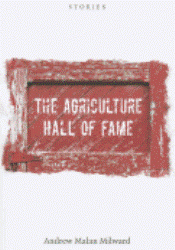
In the early morning hours of August 21st, 1863, 26-year-old Captain William Quantrill led several hundred Confederate guerillas into the town of Lawrence, Kansas, a hotbed of abolitionist support, in retaliation for the looting of Osceola, Missouri two years earlier. Quantrill and his men were looking for U.S. Senator James Lane, who had led the raid on Osceola. Lane escaped the town, running through corn fields as the sun came up, still in his pajamas, while the raiders burned the town and killed two hundred of the men and boys who lived there. By nine o’clock in the morning it was over, and Quantrill and his raiders were gone. Judging from the stories in Andrew Malan Milward’s debut collection and Juniper Prize for Fiction winner The Agriculture Hall of Fame, all of which are set in Kansas, the damage has yet to be fully undone.
Quantrill was killed in an ambush Kentucky in 1865, and Lane shot himself in the head the following year in Leavenworth. These are fates that the characters of The Agriculture Hall of Fame could identify with. Of the ten stories in the collection, almost all of them involve relationships broken by suicide or disease. It must be no mistake that Milward is from Lawrence.
What the matter is with Kansas, in the vision of it that Milward has created, is a sort of lack of guidance; a disconnect between Kansans and the world they’ve inherited, as if, somewhere along the way, the instructions were lost. In the story which opens the book, “Quail Haven, 1989”, a father keeps the remnants of his past hidden in a barn: “The greening class ring and broken-armed trophies; the lacy underwear of girlfriends gone by that on occasion, when the loneliness is overwhelming, he wraps around his index finger and brushes against his check, remembering; the letters his buddies gave him during the war to give to their families just in case…” Of course, when he eventually hangs himself in that same barn, he doesn’t leave a note behind.
In the eponymous story, a photographer chronicles the destruction of the agriculture that defined Kansas’s past. His photographs, before-and-after shots of a rubber plant and the farmland that preceded it, are exhibited in the Agriculture Hall of Fame, but he does not seem to remember them as his own. His memory is going; he is suffering from Alzheimer’s. In “Birthday” a man grapples with the birth of a child that he does not want, haunted by memories of the troubled relationship he had with his own father, and questioning if he really wants the premature baby to live. The narrator of “Ulysses” is forever a sniffling wreck, the product of his father’s death in Vietnam and his mother’s inability to recover from it. In “The Cure for Cancer” a brother attempts to deal with his sister’s serious illness, unassisted by their widowed father, who has Alzheimer’s, or his increasingly withdrawn brother-in-law. In “The Antichrist Chronicles” a mother has packed her bags and disappeared without a trace in the night, her husband subsequently unraveling. In “Silver Creek, 1969” two drunks tell lies about families they’ve long since lost, ultimately unable to cling even to a fantasy.
In short, there is no stable ground for the characters to walk on. This Kansas is one that has been reduced to rubble—drugs and alcohol and wild evangelicals—“Mom-and-Pop farms … giving way to Mom-and-Pop methamphetamine labs,” as Milward puts it.
There are hints of a reprieve in nature. A character births a foal, and is awed: “It was a beautiful thing seeing dam and foal lie together, his hind limbs still in the mare’s vagina, connected.” But it is a fleeting and tenuous connection. Elsewhere, an entire lake disappears overnight—vanishing into the earth. Farming ceases to provide a living. “This is what accounted for our amazing number of pumpkin shooting ranges, shitty Kansan vineyards, country hayrides, and corn mazes in the shape of famous Kansans like Eisenhower and Amelia Earhart.” It is telling that when agriculture can no longer provide sustenance it is relegated to a museum (the Hall of Fame), or else it becomes an outlet for violence, or a means to get lost, or a means to get wasted. There don’t look to be many other options left.
And yet all of this gloom is not as overwhelming as it might seem. Milward’s characters are so colorfully drawn, so carefully and deliberately described, that there appears always to be hope; a second chance is just around the corner, there is some glorious redemption just beyond the pages we are given. After all, things can’t be that bad, can they? The seasons keep changing, the sun keeps coming up. The fields are always burned just before the planting; if we burn down with them, where’s there left to go but up?




